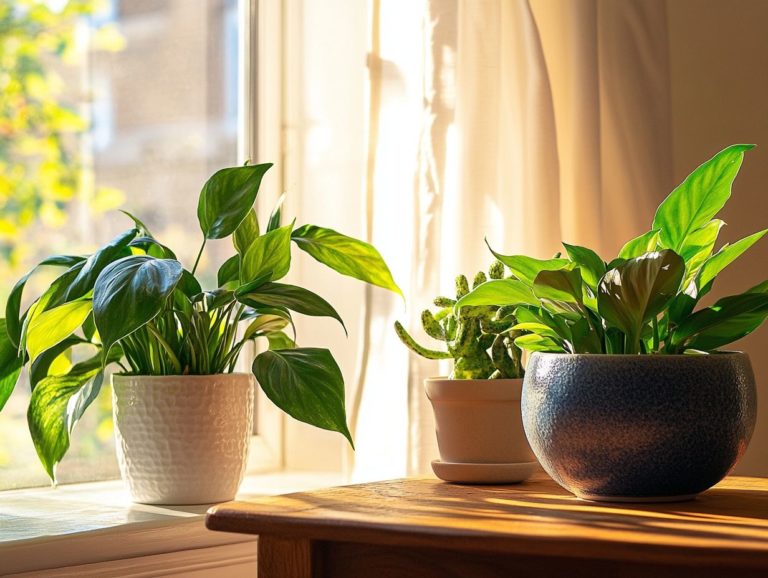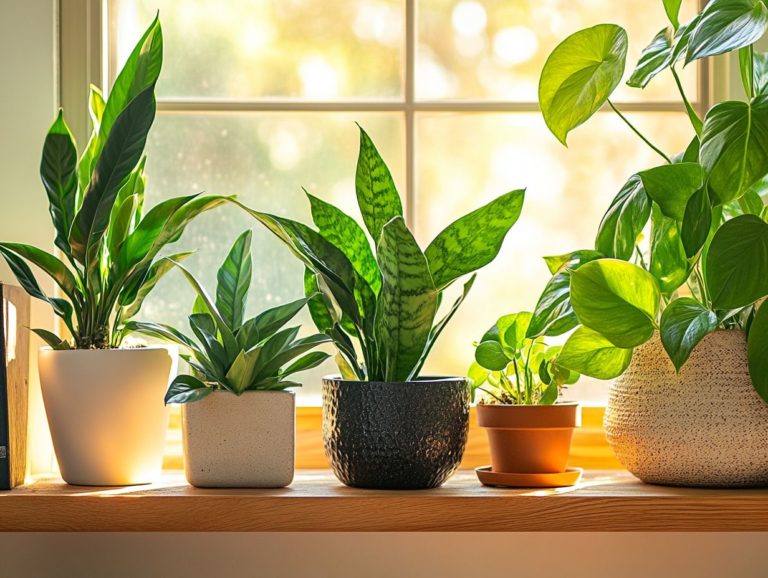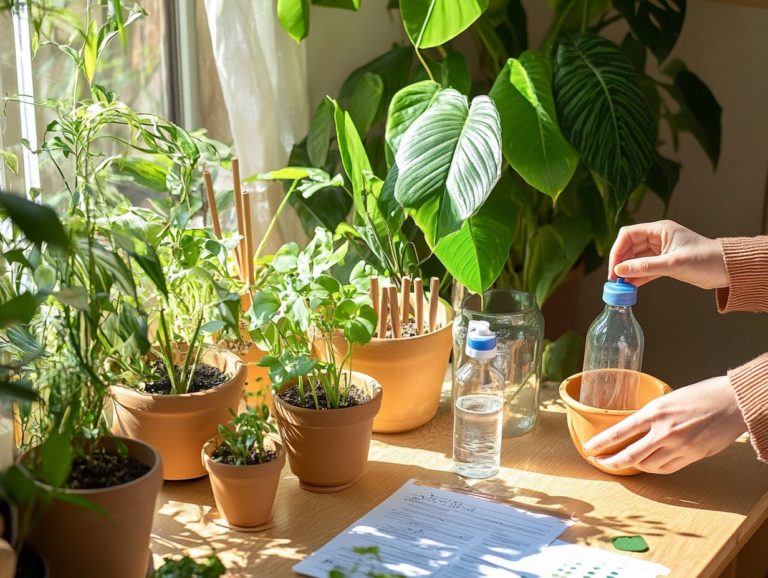How to Create a Plant Care Journal?
Keeping a plant care journal can elevate your gardening experience from a series of fortunate guesses to a carefully curated journey of growth and achievement.
By documenting essential information about your plants, you gain valuable insights and nurture a deeper bond with your green companions.
This guide explores many benefits of maintaining a plant care journal, highlighting crucial details to capture and offering tips for efficient setup.
You ll learn how to troubleshoot issues and use past data to ensure future plant care success.
Whether you re just starting or have been cultivating plants for years, this guide provides the tools you need to tend to your garden with newfound confidence.
Contents
- Key Takeaways:
- The Importance of a Plant Care Journal
- What to Include in a Plant Care Journal
- Setting Up Your Plant Care Journal
- Maintaining Your Plant Care Journal
- Troubleshooting and Adjusting Care Plans
- Utilizing Your Plant Care Journal for Future Plant Care
- Frequently Asked Questions
- What is a plant care journal and why should I create one?
- How do I start creating a plant care journal?
- Essential Information for Your Plant Care Journal
- How often should I update my plant care journal?
- Can I use a plant care journal for different types of plants?
- How can I use my plant care journal to improve my gardening skills?
Key Takeaways:

- Keep a plant care journal to track progress and spot issues.
- Include watering schedules, pest control methods, and growth observations.
- Stay consistent and organized to plan your future plant care.
The Importance of a Plant Care Journal
A plant care journal is a valuable tool for gardeners, offering a systematic way to track every aspect of your plant care journey.
From maintaining a detailed plant inventory to documenting gardening records and historical data, this journal is your essential resource.
By using it, you can record important details like planting dates, bloom times, and pest issues. This practice significantly aids in managing your landscape and designing your garden.
Each entry becomes part of a rich tapestry of creative journaling, ultimately leading to greater gardening success.
With these historical records and seasonal notes at your fingertips, you can make informed decisions that lead to flourishing results.
Benefits of Keeping Track of Plant Care
A garden journal helps you stay organized and schedule tasks effectively.
By documenting pest issues and tracking the process of growing new plants from seeds or cuttings, you can tackle challenges proactively, ensuring your plants are healthier and your gardening experience is more enjoyable.
As you note growth patterns and seasonal changes regularly, you’ll optimize your planting schedules, aligning your efforts with the best timing for seasonal crops and flowers.
This practice boosts plant health and helps you grow a thriving garden.
When you revisit past entries, you’ll understand which plants thrived under specific conditions, enabling you to make better decisions in the future.
Ultimately, a garden journal becomes an essential tool, cultivating a profound connection to the earth and yielding more bountiful gardens.
What to Include in a Plant Care Journal
In crafting your plant care journal, include a wide array of contents that capture every pertinent detail about your garden.
Consider adding thorough plant profiles that encompass planting dates and care guidelines, paired with a clear layout of your garden to facilitate effective planning for maintenance tasks.
Documenting seasonal notes offers valuable insights into optimal care practices throughout the year, enhancing both your gardening experience and the health of your plants.
Essential Information to Track
Essential information to track in your plant care journal includes critical details like planting dates. These establish the timeline for maintenance tasks and any pest issues that may arise.
Blossom times are another key indicator, signifying the health and vitality of your plants. By monitoring weather trends, you can adapt your care plans to changing conditions and ensure optimal growth.
These notations serve as the foundation for understanding your plants’ cycles. They allow you to make informed decisions about watering schedules and nutrient needs throughout the seasons.
For example, you might note the average bloom dates of your roses. This can indicate the perfect moment to apply specific fertilizers for enhanced flowering.
Keep an eye on soil moisture levels and acidity to tailor your care. Analyzing these details collectively allows you to take charge of your gardening, cultivating a healthier, more resilient garden ecosystem.
Setting Up Your Plant Care Journal

Creating your plant care journal is not just functional; it’s a fun and creative adventure! You can opt for a spiral notebook, a luxurious leather-bound journal, or a convenient digital format right on your smartphone.
Each choice offers distinct possibilities for organization and personal expression. This enables you to weave in creative journaling techniques that truly reflect your unique gardening style.
Choosing the Right Format
Choosing the right format for your garden journal can profoundly enhance your gardening experience. You have options, ranging from traditional spiral notebooks and elegant leather-bound journals to modern digital solutions like smartphone apps and Excel spreadsheets.
Traditional notebooks provide a hands-on experience, allowing you to sketch layouts or jot down notes freely, inspiring creativity and personal expression.
Leather-bound journals appeal to those who value sophistication and durability, making them ideal for long-term use. Digital formats bring unmatched convenience, with apps offering handy features to set reminders for watering and fertilizing.
This diverse selection enables you to choose a method that seamlessly aligns with your workflow, ensuring easy documentation of maintenance tasks and monitoring plant care throughout the year.
Organizing Your Journal
Effective organization of your garden journal is essential for quick access to its contents. This is particularly important when tracking maintenance tasks and garden layout preferences.
Group related entries and incorporate visual aids to enhance the efficiency of your journaling process. Thematic sections, such as plant types or seasonal activities, allow for quick references and targeted insights.
Using chronological timelines to map out planting schedules and harvest periods can greatly streamline your planning. Adding visual elements like diagrams, sketches, or photographs transforms the journal into a more engaging and inspiring resource.
The strategic inclusion of relevant keywords and entities creates a systematic approach. This makes it effortless to navigate your entries and extract actionable information when it matters most.
Maintaining Your Plant Care Journal
Maintaining your plant care journal consistently is essential for tracking your progress. Ensure that every aspect of plant care be it maintenance tasks or pest issues is documented meticulously.
Regular entries serve as a historical record for your future reference. They also enable you to make informed adjustments based on seasonal changes and evolving conditions.
Consistency and Tracking Progress
Consistency in your plant care journal is essential for effectively tracking your progress over time. You ll see amazing results as you link your journal entries with specific maintenance tasks and the evolving conditions of your plants. By regularly updating your journal, you can pinpoint patterns, celebrate successes, and identify areas that might need a little extra attention.
Setting aside a designated time each week to log your observations can transform this process from a mundane chore into a rewarding ritual. For example, by documenting light levels, watering schedules, and growth rates, you gain valuable insights into how various environmental factors impact your plants health. If you notice that your plants thrive after adjusting their sunlight exposure or humidity levels, you deepen your understanding, leading to more informed care decisions.
Incorporating insights from seasonal changes or pest issues into your journal enables you to develop proactive strategies. For example, learning how to create an indoor plant care schedule ensures that your plant care evolves in tandem with your growing experience and the shifting environmental conditions.
Troubleshooting and Adjusting Care Plans

Troubleshooting and adjusting care plans are essential elements of effective gardening, enabling you to respond swiftly to pest issues and various challenges.
By ensuring that your maintenance tasks align with your plant profiles and the ever-changing weather trends, you adopt a proactive approach that significantly enhances plant health. This practice nurtures your garden and enriches your understanding of its unique needs, allowing you to cultivate a thriving oasis.
Identifying Issues and Making Changes
Identifying issues in your garden is often the essential first step toward effective troubleshooting, whether you’re grappling with pest problems or unexpected shifts in plant health. By diligently recording your observations in a garden journal, you can make informed adjustments to your care plans that will enhance the overall vitality of your plants.
Maintaining a comprehensive record allows you to accurately assess what might be causing your plants to wilt or thrive. For instance, tracking weather patterns can shed light on how temperature fluctuations impact growth, while documenting your watering schedules helps determine if over or under-watering is at play.
Noticing the appearance of pests or signs of disease enables you to take timely action, such as implementing organic pest control methods (natural ways to manage pests without chemicals) or amending the soil. The insights gathered from these entries assist in diagnosing current problems and enable you to make proactive adjustments, ensuring that your garden flourishes harmoniously with its environment.
Utilizing Your Plant Care Journal for Future Plant Care
Utilizing your plant care journal for future gardening endeavors is a powerful strategy to ensure ongoing success. By referring back to your past data and insights, you can refine your planting schedules and maintenance tasks with precision.
This thoughtful approach to historical records can profoundly enhance your outcomes and yield, setting you up for a flourishing garden season after season. Start your journal today for better gardening results!
Using Past Data for Future Success
Utilizing past data from your garden journal can significantly enhance your future gardening endeavors, offering invaluable insights into the strategies and ideas that have thrived in your unique environment. This historical context refines your plant care techniques and optimizes maintenance tasks.
By diligently documenting daily observations, weather fluctuations, and plant performance, you’ll be able to identify patterns that drive growth and yield. This thoughtful practice enables you to make informed decisions about what to plant and when, while illuminating the specific conditions that favor various species.
For instance, tracking the best times to harvest your plants can unveil the most rewarding varieties suited to your local climate, while noting pest issues can guide your preventive measures. Ultimately, this analytical approach transforms your garden into a personalized ecosystem, where data-driven choices lead to flourishing plants and bountiful harvests.
Frequently Asked Questions
What is a plant care journal and why should I create one?

A plant care journal is a record-keeping tool used to track the care and progress of your plants. It includes details like your watering schedule, pest control actions, and growth patterns. Creating one helps you monitor your plants’ needs and enhances your gardening skills.
How do I start creating a plant care journal?
The first step is deciding on your journal’s format. You can use a physical notebook or create a digital journal using apps or spreadsheets. Next, gather all necessary information such as plant names, care instructions, and growth details.
Essential Information for Your Plant Care Journal
Apart from basic details like plant names and care instructions, include information such as the date of purchase, repotting schedule (which means transferring a plant to a larger pot for continued growth), fertilizer usage, and any issues your plants may encounter. You can also add photos to track how your plants grow.
How often should I update my plant care journal?
Make it a habit to update your plant care journal every week! This will help you catch any changes in your plants quickly and address any issues promptly.
Can I use a plant care journal for different types of plants?
Yes, you can use a plant care journal for all types of plants, including indoor and outdoor plants, succulents, and herbs. Create separate sections or pages for different plant types to keep your journal organized.
How can I use my plant care journal to improve my gardening skills?
By regularly updating your journal and tracking your plants’ progress, you can identify patterns and trends in their growth and care. This understanding will help you make adjustments to improve your plants’ health and well-being.






